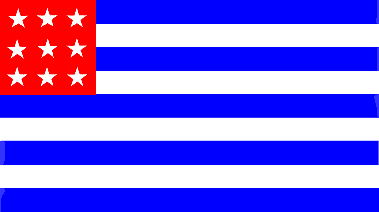 image
by Fred Drews, 12 November 2002
image
by Fred Drews, 12 November 2002
Last modified: 2020-04-19 by rob raeside
Keywords: el salvador | nonualcos |
Links: FOTW homepage |
search |
disclaimer and copyright |
write us |
mirrors
See also:
Other sites:
The El Salvadorian Stars and Stripes with 9 stars had a square
canton. It was adopted on 28th April 1865. The law described the
canton as having as many stars as there are provinces, but we
have no records about flags with eleven or thirteen stars (which
would have been possible), but a postage stamp of 1867 shows the
arms with eleven stars and one of 1879 with thirteen stars(!).
With number of stars rising the canton became longer.
The ensign had the coat of arms in the canton, but only on the
obverse! On the reverse the stars were shown! So it happens that
in the arms there are two flags. Sometimes the great coat of arms
was shown, sometimes a lesser version, sometimes within a white
circle sometimes directly on the red field.
The official name of the state was "El Salvador" since
12 June 1824 but as the Magna Carta of 1824 wrote: "El
Estado se denominar? Estado del Salvador.", the name
"Salvador" was used. From 1896 the name "El
Salvador" was used on postage stamps, on coins it came in
use in 1911, and a decree of 1915 prescribed the name "El
Salvador" always to be written "...de El Salvador"
and not "...del Salvador".
Sources are El Salvadorian literature, official El Salvadorian
Flag book.
Ralf Stelter, 13 June 1999
The evolution of the Salvador flag between 1865 and 1912 seems
to be confuse. Anyway, Znamierowski 'solved' the problem by
showing only the flag with 14 stars as 'Salvador, 1865-1912'.
This is quite approximate because we know the adoption date of
the flag with only 9 stars (28 April 1865) and the year of
creation of the 14th province, 1877.
Ivan Sache, 18 March 2001
While in Washington DC I was very lucky and found the
official newspaper of the government of El Salvador from 1865 as
well as the local Salvadoran newspaper from the same year. I
found the following information in Spanish from both
publications: "El Constitucional Periodico Oficial del
Gobierno del jueves 4 de mayo de 1865" and "el diarrio
El Faro del 8 de mayo de 1865".
Here is the law in Spanish of the flag dimensions and the crest:
REPUBLICA DEL SALVADOR EN LA AMERICA CENTRAL
EL CONSTITUCIONAL.
PERIODICO OFICIAL DEL GOBIERNO.
TOMO 1. San Salvador Jueves 4 de mayo de
1865 NUM. 82
PARTE OFICIAL
MINISTERIO DE RELACIONES EXTERIORES E INSTRUCCION PUBLICA.
Decreto del Gobierno designando los colores del pabellon nacional
y atributos del escudo de armas de la República.
El Presidente de la República del Salvador.
Cumplimentando el decreto del Cuerpo Legislativo de 14 de Febrero
último que lo faculta para designar los colores del pabellon
nacional y los atributos del escudo de armas, se ha servido
decretar lo siguiente.
Artículo 1o -- El pabellon nacional se compondrá de cinco fajas
azules y cuatro blancas: el ancho de dichas fajas será de nueve
pulgadas y su longitud de tres á cuatro varas castellanas. En el
ángulo superior inmediato al asta, llevará un cuadro encarnado
de una vara por lado, en el cual se colocarán nueve estrellas
blancas de cinco ángulos salientes cada una, representando los
nueve departamentos de la República.
Art. 2o -- La bandera antedicha será la mercante. La de guerra
tendrá los mismos colores y dimensiones y en el cuadro encarnado
de que se ha hecho mencion, tendrá el escudo de armas de la
República, llevando al reverso las nueve estrellas de los
departamentos.
Art. 3o -- El escudo de armas nacional será el mismo de la
antigua federacion centro americana con las modificaciones
siguientes: 1a. en lugar de los cinco volcanes que representaban
los cinco Estados de la federacion habrá solamente uno en
actividad imitando al Izalco: 2a. en el espacio superiro del
cuadro que debe contener este volcan se colocarán las mismas
nueve estrellas formando semicírculo: 3a. en la base del escudo
aparecerá de un lado y otro el nuevo pabellon de la República:
4a. el gorro de la libertad descansará en la parte en que se
unen los cuernos de la abundancia que descienden por ambos lados
cuadro: 5a. en forma de semicírculo, se leerá entre rayos
luminosos: 15 de Setiembre de 1821, quedando el gorro en el
centro de éste: y 6a. limitará el escudo una franja circular en
cuya circunferencia aparecerá esta leyenda: República del
Salvador en la América Central.
Art. 4o -- El Ministro de Relaciones se encargará del
cumplimiento y publicacion de este decreto.
dado en San Salvador, á 28 de Abril de 1865
Francisco Duenas
El Ministro de Relaciones Exteriores é Instruccion Pública:
Gregorio Arbizú.
Here is the translation of the Artículo 1o which describes the
dimensions of the flag:
Article 1 - The national flag will consist of five blue stripes
and four white ones: the width of each stripe will be nine inches
and its length would be of 3 or 4 varas castellanas (one vara castellana equals 36 inches) . In the upper corner next to
the flag pole, there will be a red square of one vara (36 inches)
per side, placing nine white five pointed stars,
representing the nine departments of the republic.
So this clears the doubt about the size of the flag and its
components. The red square remained a square as stars were
added, according to the law of 1898 that describes
the flag of the Republica Mayor de Centroamerica and the
one from 1912 they both mentioned that they will
substitute the flag of the 9 stripes with the red square and 14
stars.
Here is a photo of a flag
with 14 stars used during independence at the celebrations at the
beginning of the century. Also here are images of 9, 11,
12, 13, 14 star flags and also the national ensign and its variant .
Fred Drews, 6 August 2001
According to the law decree that I found , they gave two
official sizes that could be used for the flag.
For the 1877 flag the one that was officially used in public
events as shown on the picture taken at the park, but there was
another version that I have seen used on books and a flag that I
have from the period.
On the flags with the coat of arms (National Ensigns), the decree
specifies that the whole coat of arms will be placed on the flag,
but on stamps and coins of the period they show sometimes
the use of the whole coat of arms on a white circle or just part
of the coat of arms.
Fred Drews, 9 August 2001
This leaves me with several questions:
1. What was used between 1821-1865?
I understand that BWB triband was used, or was it? The historical
outline is quite complicated for these years, Salvador being part
of the kingdom of Guatemala and this at times federal part of
Mexico, one declaring independence from the other at times... What
was used before 1821, anyway?
2. The 1865 flag is well documented with the legislative
documents, however, I think that the image might be discussed.
Namely, the Article 1 of the legislation give detailed
construction sheet: 7 stripes of 9" wide, square canton of 1
v.c. (=36") and length of stripes 3 or 4 v.c.
This last is, in my interpretation the description of length of
top four stripes being 3 v.c. and lower 5 stripes of 4 v.c. being
longer for the width of the canton.
Fred Drews interpret this as two possibilities for the overall
ratio, which is not correct, I think. If I am correct that the
overall flag size is 81"x144", i.e. the ratio is 9:16.
(and 63"x108" flag is inexistent). Of course, Fred
might have other reasons for believing there was 3v.c. long flag
of which I am unaware.
Ralf Stelter writes that the ensign had different reverse from
the obverse, namely while on he obverse there was the Coat of
Arms in the canton, on the reverse there was stars as in the
national flag. This is almost un-noticeable and it might be good
to point it better by placing reverse images next to the obverse
by each of the ensigns.
3. Finally, the stars and stripes flag was abandoned in 1912.
Why, what happened then? Just a
"whim"/"nostalgia"? There must have been some
political background. Anyhow, we claim (as does Smith) that the
current BWB triband was adopted in 1972. That means that we have
60 years of kind of void. Can anyone fill it in? If the changes
in 1972 legislation are no more then further elaboration of
earlier design, there is not much sense in quoting it as the
adoption date.
Wouldn't something of the sort be better: "Adopted in 1821,
abandoned 1865. Reintroduced 1912, last legislation 27 Sep.
1972." ?
Željko Heimer, 8 January 2003
"The national flag, also navy flag, was used from 1838
till 1865, and later from 1912 on. Till 1972 it had the unusual
proportions of 189:335; that was changed to 3x5.
Base was the flag of the Central American Federation of 1823.
Some years after the collapse of that federation (1841) El
Salvador ditched all thoughts of federation, in adopting a new
flag, which reminded of the S&S of the USA of 1865-1912. ...
In 1912 El Salvador readopted the old flag. ...
15 Sep 1912 El Salvador readopted the Coat of Arms, which had
been used 1851-1858, which reminded of the old attempt at
federation."
Source: "Flaggen, Wappen, Daten", 1975 [hes75]: (my translation)
In 1912 the president of El Salvador, General Tomas Regalado,
declared that he was willing to obey the Constitution, and in so
doing he had (the first) free elections held in 1913. I suppose
that that important resolution also prompted the change in
symbols.
Source: "Survol Historique des Pays d'Amérique
Latine", by Francis V. Féraud, 1959.
Jarig Bakker, 21 February 2005
Jarig wrote: "Till 1972 it had the unusual proportions
of 189:335" - Not according to the Decree of 1972 (see here) it wasn't. Article 7 says
"The great flag [la bandera magna] will be three meters and
35 centimetres in length by one meter and 89 centimetres in
width, on which will be paced the coat of arms with all its
accoutrements...".
I do not have a copy of the Decree of 1912 or of 1916 (which
apparently modified it), so have no way of knowing whether the
unusual proportions were carried over from the previous
legislation or were entirely new. Either way, unless
there are supplementary regulations of a later date the ratio of
189:335 stands (at least for the largest size of official flag).
Christopher Southworth, 21 February 2005
There was no state or republic of El Salvador before 1824.
There only was San Salvador and the struggle to unite all of
Central America as a force against Mexico. On 11 January
1822 the authority of San Salvador and San Vincente declared
their total independence from Mexico and Spain. Santa Ana and
Sonsonate did not join, but declared themselves parts of Mexico.
On 20 February 1822 Salvador adopted the
"celeste-blanco-celeste" flag, when soldiers were sworn
in for the fight for independence against Mexico. They adopted
the colours of Belgrano and San Martin, who have been successful
in South America. On 1 July 1823 the independence of the
United Provinces of Central America was declared. On 13 November
1823 the "Alcadia mayor de Sonsonate" and the
"Intendencia de San Salvador" united for a
"indivisible unit", in effect on 22 December. On 7
February 1824 Ahuachapán separated from the former province of
Sonsonate and joined San Salvador. On 5
march 1824 delegates from Sonsonate and San Salvador met, on 12
June they published the constitution of "El
Salvador", "a federal state within the union".
These facts show that El Salvador was not a founder member
of the federation, but only grew together during te first year.
So the question is not "which flag was used by El Salvador
before 1822 (!)?" - El Salvador wasn't created before 1824.
The question should be "which flags were flown in those
parts which later united to El Salvador?"
Before 1821 the Spanish flag must have been used. The
independence declaration of Guatemala was sealed with the Spanish
seal! Salvador declared her own independence, as they did not
want to become a part of neither Guatemala nor Mexico. I think
they had no flag, as they adopted their first flag,
celeste-blanco-celeste, when they prepared for war against
Mexico.
As to the current flag - Adopted 1822 (not 1821!), minor
modifications 1841, abandoned 1865. Reintroduced with minor
modifications in 1912, slightly modified in 1916, last
legislation or confirmation 1972.
There are no 60 years of kind of void. Salvadorian literature
tells that Salvadorenos were proud of their flag and so they kept
it (the federal flag in fact was the flag of Salvador and not
vice versa). In 1841 the coat of arms was slightly
modified. The idea of a new federation was still in the
Salvadorians' head. In a law of 30 January 1841, Salvador
declares her independence as "Republica del Salvador",
the constitution of 22 February 1841 again says
"Estado"! In 1842 Salvador becomes a member of the
"Confederacion Centroamericana" with a constitution of
17 july 1842. This lose confederation lasts until 1845. In 1849
the "Federacion de Centroamerica" is founded, which
renames "Republica de Centroamerica" in 1852. In 1859
Salvador "throws away" the federal idea and names
herself "Republica de El Salvador". To underline her
withdrawal El Salvador adopts a new flag in 1865. Historians write
"the first flag since the federal flag, as El Salvador used
to use the federal flag until that year" (this
still clears nothing: was it a federal flag with own arms or
federal arms? - same historians write that in 1841 the coat of arms was
slightly modified...) In 1912 the flag of today was adopted.
Decree of 17 may 1912, published on 30 may and nationwide hoisted
for the first time on 15 September 1912. President D.
Aranjio had initiated the return of the flag. The flags in use
were a national flag (plain), a national flag at sea (silver
letters DIONS UNION LIBERTAD), state flag on land and at sea
(same with gold letters), a flag for the Diplomatic Corps and
their ships (coat of arms in the center). Official dimensions of the flag:
3.35 x 1.89 m, other dimensions may be used as long as the
stripes are equal and of the same colour. The law about the coat of arms
is of the same day but was modified by decree of 20 may 1916. The
law described a coat of arms which was similar to the one of Nicaragua
with different inscription. The later decree added flags and
wreath, to differentiate it from the Nicaraguan Coat of Arms. In
1972 the use of the flags was changed slightly.
Ralf Stelter, 22 February 2005
Guatemala which belonged to the Virreinato of Mexico was called
Capitanía General de Guatemala and this was divided in several
Intendencias all the way to the Panama border (now Costa
Rica). Being the first one, San Salvador was created by the King
Carlos III on September 17, 1785. Each intendencia had its own
intendente (governor) who took oath under the king and the limits
were created then for San Salvador: this included San Miguel, San
Vicente and San Salvador which included also Gran Santa Ana. Only
what is was called the Alcaldia mayor of Sonsonate and Ahuachapan
were part of Guatemala, this two became part of San Salvador in
November 1823 to form the current limits of present El Salvador.
In 1808 the king promulgates a coat of arms for the intendencia
of San Salvador. which is used on offices and official
correspondence of the intendencia and minted in coins. On January
11, 1822 the Intendencia of San Salvador segregates itself from
Guatemala which had joined the Mexican Empire. On June 12 1824 La
intendencia of San Salvador writes its first constitution and
changes its name to Estado del Salvador. The Spanish flag
with the coat of arms of the period was the flag that flew at the
time untill 1821. After independence on September 15, 1821 the
flag that flew was still the Spanish flag but all the emblems and
coat of arms were removed. Then the flag of the Mexican empire
flew in certain parts of the intendencia and the new adopted
light blue white light blue was flown from February
1922. The blue white blue flag was flown untill 1865 changing
only the coat of arms in different occasions. And the Dios Union
Libertad flag also flew at this time. In 1898 for 20 days the
blue white blue flag was reinstated and raised Nov 2 with the
coat of arms of the Republica mayor de centroamerica, then went
back to the 1865 flag until 1912. In 1911 the president Manuel
Enrique Araujo celebrated on November 11, 1911 the centenary of
the first independence movement that proclaimed independence in
San Salvador until it got suppressed at that time. Araujo then he
started the movement to go back to the original flag and in may
1912 the Assembly voted to have it reinstated, being raised
officially on September 15, 1912 by the president. The 1912 law
specifies its colors, use and size. In 1916 there were
modifications made to the law concerning the coat of arms. as
well as in 1932. The 1970 law also altered slightly
the Coat of Arms removing the red star. And adds to
the current size specified in the 1912 law new sizes
for the flag to be used on buildings, offices and parades.
Fred Drews, 26 February 2005
 image
by Fred Drews, 12 November 2002
image
by Fred Drews, 12 November 2002
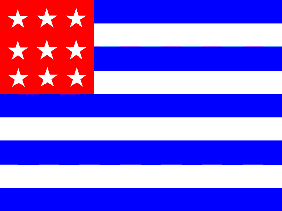 image
by Fred Drews, 12 November 2002
image
by Fred Drews, 12 November 2002
The previous flag of El Salvador (official name), was in
effect from 1865 to 1912. It started with only 9 stars positioned
in rows of 3, 3, 3 in the red canton.
Fred Drews, 9 September 1999
Concerning the 1865 flag, Ralf Stelter's introduction
clearly states that the flag canton was square, although the
preview is a bit ambiguous.
Ivan Sache, 18 March 2001
The names of the nine departments once represented in the
canton were: "San Salvador, Santa Ana, San Miguel,
Sonsonate, San Vicente, La Paz, La Libertad, Chalatenango (and)
Cuscatlán".
Jan Mertens, 8 February 2005
National Ensigns
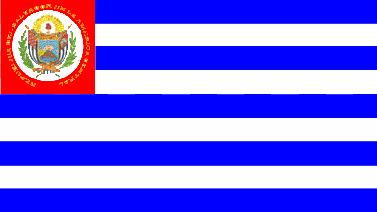 image
by Fred Drews, 12 November 2002
image
by Fred Drews, 12 November 2002
obverse
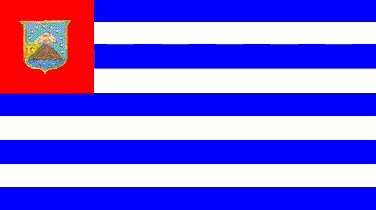 image
by Fred Drews, 12 November 2002
image
by Fred Drews, 12 November 2002
obverse
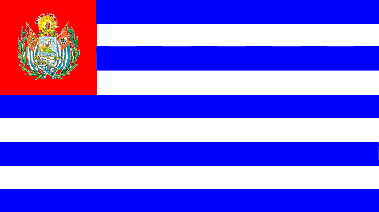 image
by Fred Drews, 12 November 2002
image
by Fred Drews, 12 November 2002
obverse
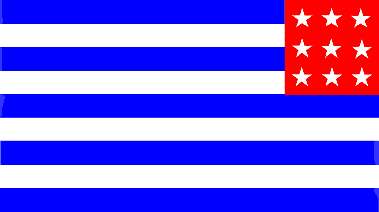 image
by Fred Drews, 2 May 2005
image
by Fred Drews, 2 May 2005
reverse
At the time there was in use another flag (the national
ensign), that instead of having the stars in the canton, it had
the coat of arms of that period.
Fred Drews, 9 September 1999
In a photo taken in
1911, there is the flag used by the military during a parade. The
flag shows the red square with the national coat of arms placed
directly on the red and not in a white circle.
Fred Drews, 29 May 2002
Reported Flag
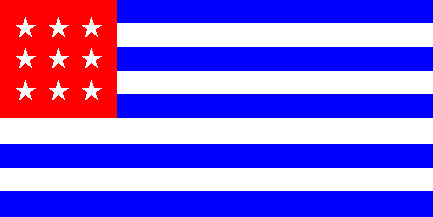 image
by Ivan Sache, 18 March 2001
image
by Ivan Sache, 18 March 2001
Based on image provided by Fred Drews.
Reported National Ensign
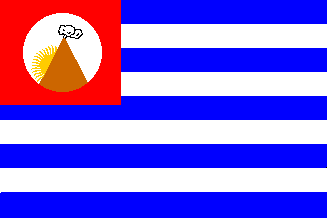 image
by Horta and Ivan Sache, 18 March 2001
image
by Horta and Ivan Sache, 18 March 2001
Note: on the reverse there was stars as in the national
flag
I found this flag in a very old encyclopedia, it is part of
the Coat-of-Arms of El Salvador and it's displayed on the right
side of the Coat, on the left side there's another flag (this one
already mentioned above).
Horta, 7 July 1998
The 'National ensign' is not an alternative ensign but the
reverse of the national flag, obverse and reverse of the flag
being placed on either side of the coat of arms according to
Ralf's introduction. I suspect the image should have a proportion
of 1:2 like all of the other flags of that period but I have no
solid evidence for it.
Ivan Sache, 18 March 2001
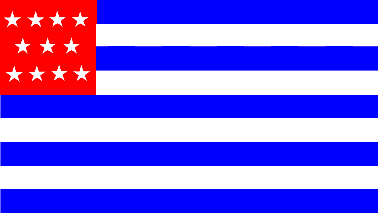 image
by Fred Drews, 12 November 2002
image
by Fred Drews, 12 November 2002
![[El Salvador - 1869]](../images/s/sv-1869.gif) image
by Fred Drews, 12 November 2002
image
by Fred Drews, 12 November 2002
By 1869, 3 more departments were added (2 in June, 1865, and one in February, 1869) increasing then the number of stars to 12, positioned in rows of 4, 4, 4 in the red canton.
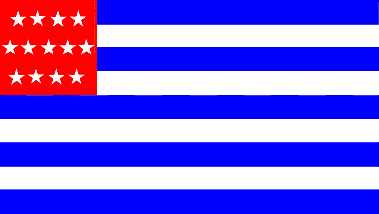 image
by Fred Drews, 12 November 2002
image
by Fred Drews, 12 November 2002
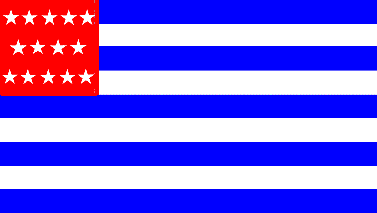 image
by Fred Drews, 12 November 2002
image
by Fred Drews, 12 November 2002
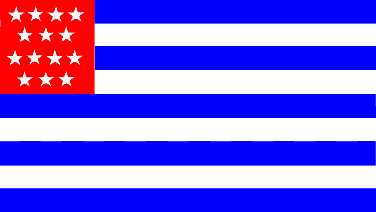 image
by Fred Drews, 12 November 2002
image
by Fred Drews, 12 November 2002
By 1877, 2 more departments were added (one in February, 1873,
and one in February, 1877) increasing then the number of stars to
14, positioned in rows of 4,3,4,3 in the red canton. The flag is
from1875.
Fred Drews, 9 September 1999 and 29 May 2002
A variant of the 4, 3, 4, 3 pattern used a pattern of 5, 4, 5,
as shown by Andrees Handatlas of 1921 (7. Auflage).
Jarig Bakker, 15 January 1999.
![[El Salvador - 1877]](../images/s/sv-1877.gif) image
by Ivan Sache, 18 March 2001
image
by Ivan Sache, 18 March 2001
The 1877 flag, with 14 stars in canton, is shown by
Znamierowski [zna00) with
proportion 1:2. The proportion seems also to be 1:2 on the
preview of the 1877 coat of arms below.
Ivan Sache, 18 March 2001
![[El Salvador - 1877]](../images/s/sv_pil89.gif) image
by Ivan Sache, 1 November 2018
image
by Ivan Sache, 1 November 2018
"Album des pavillons nationaux et des marques distinctives des marines de
guerre et de commerce" (1889) shows the pilot flag of El Salvador with the same
design as the canton of the national flag adopted in 1877.
Ivan Sache, 1
November 2018
1865
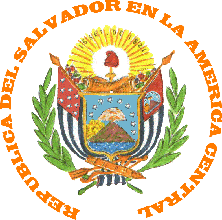 image
by Fred Drews, 24 August 2001
image
by Fred Drews, 24 August 2001
1875
1877.gif) image
by Fred Drews, 24 August 2001
image
by Fred Drews, 24 August 2001
1912
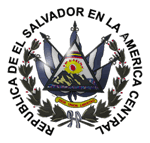 image
by Guadalupe Lindo, 12 October 2002
image
by Guadalupe Lindo, 12 October 2002
The arms of the period were: a shield containing a volcano in
the middle surrounded by water and on the left side of the shield
the previous flag discussed, and on the right side the same flag
but with the coat of arms in the red canton (I will send a gif of
one in the future).
The red canton has a depth of 5 stripes.
Fred Drews, 25 September 1996
I decided to create the coat of arms exactly as they were
during the period. I took post stamps, tax stamps, coins and post
cards of the late 1800s and beginning of the 1900s. All had the
same emblem on them so I created the following coat of arms
from them, which follows the exact description of the law.
Fred Drews, 24 August 2001
In XIX century the Indians revolted against conscription and
proclaimed their leader Aquino as king. Kingdom occupied a part
of El Salvador. The full history was published in issue 1 of Flag
Report.
Jaume Ollé, 3 October 1999